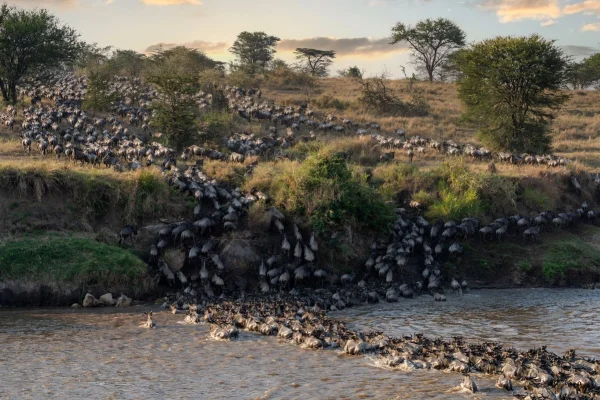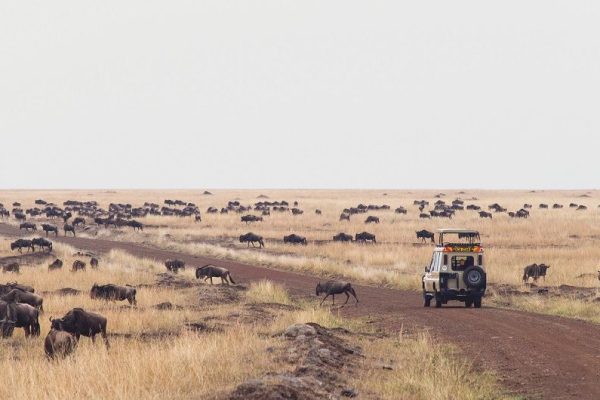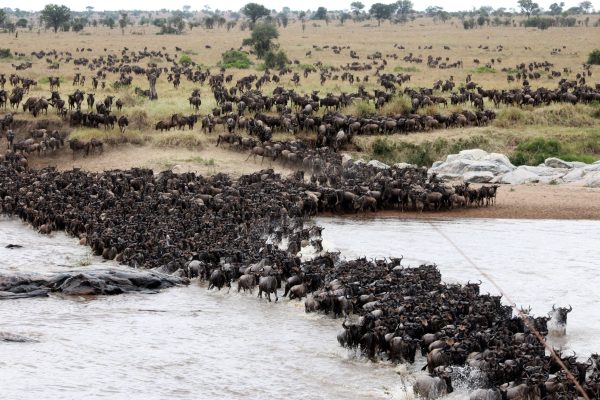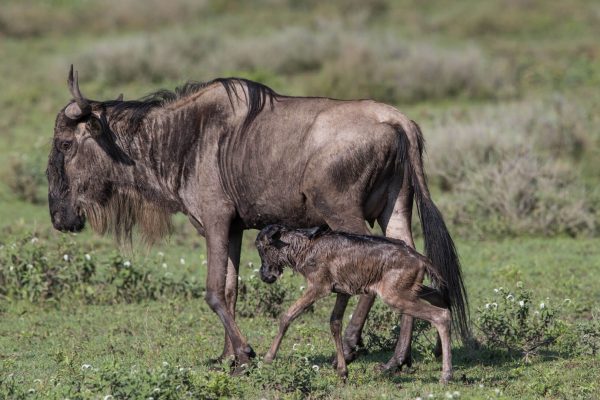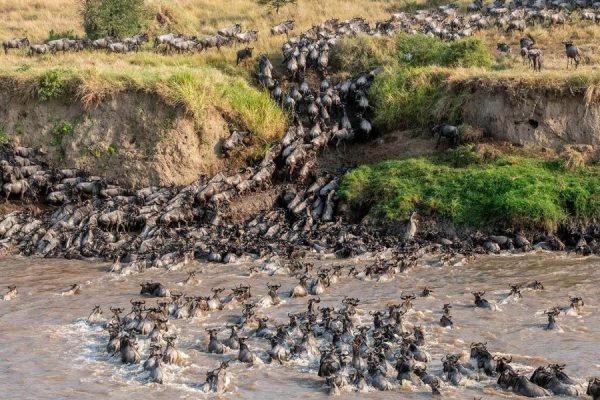The Great Wildebeest Migration Tracker, Facts & Map
The Great Wildebeest Migration Tracker, Facts & Map: How the Great Wildebeest Migration moves throughout the year, When Is The Best Time To Go On A Wildebeest Migration Safari, Where Are The Best Places To Stay On A Migration Safari, What Are The Best Wildebeest Migration Safari Packages.
The Great Wildebeest Migration in Tanzania and Kenya is one of the world’s natural wonders as the herds are the largest that can ever be spotted in the wilderness. Tanzania is one of the planet’s most impressive wildlife events as millions of animals roam through the Tanzania Serengeti and Kenya’s Maasai Mara ecosystem.
The wildebeest migration safari is one of the world’s natural wonders as the herds are the largest that can ever be spotted in the wilderness. Wildebeest (Connochaetes taurinus) is a member of the antelope family and is also known as the gnu. They are identical to having a large, box-like head with curving horns.
The front end of the body is heavily built and the hindquarters are slender with spindly legs. The wildebeest coat is gray with a black mane and a beard either white or black. The specific wildebeest species that forms the large herds of the Serengeti-Mara ecosystem are the white-bearded wildebeest. For where to find the wildebeest all throughout the year, here is a guide on where to see the wildebeest each month of the year either in the Serengeti or Mara.
The Great Wildebeest Migration
The Great Wildebeest Migration, a highly coveted experience for wildlife and nature aficionados, involves the continuous circular migration of over a million animals inside the Serengeti-Mara habitat.
The relentless migration of wildebeest, accompanied by several allies, adheres to a time-honored path in pursuit of sustenance and hydration. Following calving in the southern region of Tanzania’s Serengeti adjacent to the Ngorongoro Conservation Area, the animals migrate through the Serengeti in a clockwise trajectory towards the Masai Mara in Kenya, then returning towards the year’s conclusion. Throughout the journey, intense drama persists, as numerous creatures fall prey to predators while countless others are born, replenishing populations and continuing the cycle of life.
The Great Wildebeest Migration Safari Packages
At Kabira Safaris Africa, we acknowledge the individuality of each traveler. Consequently, our itineraries for the Great Wildebeest Migration in Africa are meticulously designed to align with your tastes. We consider the scheduling of your safari, desired highlights, preferred level of adventure, and suitable lodging style.
Whether you are keen to photograph the dramatic river crossings or desire to observe the scene from a hot air balloon, we will assist in creating the ideal schedule for you.
Tips For Planning Your Great Wildebeest Migration Safari
- Book early: At a minimum, one should plan at least one year in advance. Accommodations at lodges and camps are quickly occupied, particularly during the period from June to October, which is ideal for a Great Wildebeest Migration safari. Keep in mind that this is the peak season for safaris and when the well-known river crossings occur. However, you can observe the herds at any time during the year.
- Arrange your timing carefully: The Migration is a continuous journey that occurs throughout the year, and certain sections of the journey, like as river crossings, are unpredictable. The optimal timing for embarking on a Wildebeest Migration safari is contingent upon your desired sightings and experiences.
- Go private: The national parks have significant levels of congestion during the peak safari season, which spans from June to October. If you desire both exclusivity and easy access to the herds, it is advisable to lodge in a private reserve or conservancy.
Peruse the Great Wildebeest Migration safaris we suggest below, or contact one of our Africa Safari Specialists to assist you in customizing an itinerary that aligns with your travel preferences:
3 Days Serengeti Migration Safari
Witness the magnificent Great Migration during a 3-day safari in Serengeti National Park and the Ndutu region, where extensive herds of wildebeest and zebra traverse the plains in a striking exhibition of nature. This premium Three Days Serengeti Migration Safari provides exclusive game drives in unique wildlife regions, an exhilarating hot air balloon safari over the Serengeti, and opulent lodgings that harmonise comfort with immersive natural surroundings.
Serengeti and Masai Mara Safari
This 8-day safari in Kenya and Tanzania is the optimal selection for travellers seeking to experience the remarkable annual migration and the abundant, diverse big game present in both countries. Visited locations comprise the renowned Masai Mara National Reserve in Kenya and Serengeti National Park in Tanzania. Your safari will commence at Masai Mara, Kenya’s premier reserve, renowned for its diverse wildlife, offering unlimited game drives throughout your three-night stay.
Wildebeest Migration Crossings
What is a wildebeest crossing? The wildebeest migration is an annual phenomenon occurring in the Masai Mara of Kenya and the Serengeti of Tanzania, during which millions of wildebeests, zebras, and other species across the Great Mara River from July to October. Various crossings occur throughout these months. Nowhere else in the world can one witness the extraordinary spectacle of millions of animals migrating across plains and rivers, except in the Masai Mara and Serengeti.
Wildebeest Migration Serengeti
The Great Migration of Wildebeests The Serengeti, located in Tanzania, is characterised by a yearly round migration traversing Tanzania’s Serengeti National Park and extending into Kenya’s Masai Mara. The migration is propelled by the necessity for new grazing and water sources, including some 1.8 million wildebeest, in addition to hundreds of thousands of zebras and gazelles. The migration is a year-round phenomenon, with several phases occurring in different regions of the Serengeti at various times of the year.
Wildebeest Calving Season
The calving season of the wildebeest migration during the Great Migration transpires annually between January and February. Despite the migration route’s consistency across millennia, the precise timing of the trek fluctuates according to seasonal precipitation. Consequently, these months of this remarkable event should be regarded as a provisional estimate. The extensive herds typically search for new pastures in Tanzania’s southern Serengeti from January to March. The wildebeest migrate as far south as the Ngorongoro Conservation Area, but do not enter the Crater proper.
Wildebeest Migration Masai Mara
The Wildebeest Migration in the Masai Mara, referred to as the Great Migration, is a natural event characterised by extensive herds of wildebeest, zebra, and other ungulates traversing a round path between Tanzania’s Serengeti and Kenya’s Masai Mara. This migration is chiefly motivated by the quest for sustenance and hydration, in response to precipitation and the emergence of fresh vegetation. The most spectacular aspect of the migration, the river crossings, generally takes place in the Masai Mara from July to November as the herds traverse the Mara River, frequently facing crocodiles.
The Great Wildebeest Migration Facts
Various natural occurrences take place globally, although only a handful can rival the immense scale of the yearly Wildebeest Migration across the Serengeti-Mara Ecosystem. The sheer magnitude of the numbers is astounding: as many as 2 million animals, including wildebeest, zebra, and gazelle, embark on a perilous 3,000-kilometer (1,900-mile) journey driven by the rains and their innate instincts.
The migration of the herds is a grand spectacle characterized by immense drama, as they face various difficulties and adversities while transitioning between different regions. These animals are frequently targeted by predators, particularly Africa’s large felines such as lions, leopards, and cheetahs, as well as the enormous crocodiles that ambush them at several river crossing locations.
What is the Great Wildebeest Migration
The Great Wildebeest Migration constitutes the most extensive animal herd movement on Earth. Indeed, with densities reaching 1,000 animals per km², the vast herds of wildebeest are observable from orbit.
Remarkable figures indicate that more than 1.2 million wildebeest and 300,000 zebras, along with topi and various gazelle species, perpetually traverse the Serengeti-Mara environment in pursuit of nourishing grass and water. Driven by survival instinct, each wildebeest traverses 800 to 1,000 kilometers on its solitary journey along traditional migration pathways. Ravenous predators such as lions, leopards, cheetahs, hyenas, wild dogs, and crocodiles ensure that only the most robust endure in this natural phenomenon, often referred to as ‘the greatest show on Earth.’
The circuit transports animals from the Ngorongoro Conservation Area (excluding the Crater) in southern Serengeti, Tanzania, traversing through the Serengeti and into the Masai Mara in Kenya before returning. The expedition is fraught with peril: small calves are seized by predators, the sluggish are hunted by lion prides, valiant animals get injuries on steep riverbanks, crocodiles claim their portion of the laggards, and the frail and fatigued succumb to drowning.
The three categories of migratory grazers exhibit distinct grazing behaviours: one group consumes the upper portions of the tallest grass, while the subsequent group targets the medium-height grass, ultimately depleting it before the herds relocate. This indicates that each group adheres to its own category, with minimal overlap in their distributions. The plains’ grasses possess the highest protein content in the Serengeti and are also rich in calcium.
The mechanism by which wildebeest determine their migratory path remains ambiguous; nonetheless, it is widely accepted that their movement is predominantly influenced by climatic conditions, specifically their pursuit of rainfall and the emergence of fresh grass. Although there is no empirical evidence, some experts think that animals respond to distant lightning and thunderstorms. It has been proposed that wildebeest can detect rainfall from over 50 kilometers away.
The Great Wildebeest Migration Tracker
The Great Wildebeest Migration is a continuous, circular migration of over a million animals across the Serengeti-Mara environment, and it is one of the most sought-after events for wildlife and nature aficionados. Wildebeest and their many traveling buddies travel in seemingly endless columns down a well-worn path in search of pasture and water. The animals leave the Serengeti in the south of Tanzania, near the Ngorongoro Conservation Area, to travel clockwise via the Serengeti to the Masai Mara in Kenya, and then return to the Serengeti in the late fall. As thousands of animals are killed by predators and thousands more are created, maintaining the balance of nature, great drama is guaranteed at every turn.
The Great Migration in January, February and March
In January each year, the migration concludes its southward journey, traversing the eastern boundary of the Serengeti and entering the Ngorongoro Conservation Area. The plains are abundant in nutrient-rich grass, offering optimal conditions for herds to rear their newborn calves.
While there is no definitive beginning or conclusion to this migratory cycle—aside from birth and death—it seems logical to designate the wildebeests’ birthing season as the commencement of the migration. In late January or February, the herds inhabit the short-grass plains that extend across the lower northern slopes of the Ngorongoro Crater highlands and surrounding Olduvai Gorge. Approximately 400,000 calves are born here over a span of two to three weeks, equating to nearly 8,000 new calves daily.
The prevalence of susceptible young calves prompts nearby predators to engage in hunting, facilitated by the substantial population of wildebeest. Individuals eager to observe calving and the spectacle of large felines during hunts may consider Asilia’s migratory camps in the southern Serengeti, including Olakira, Kimondo, and Ubuntu, which offer direct access.
The Great Migration in April and May
Following the birth of their offspring in February and March, the wildebeest herds commence their migration northwest in April, seeking the verdant pastures of the central Serengeti, accompanied by hundreds of zebras and smaller assemblages of antelope. In May, extensive columns of wildebeest extend for several kilometres as the animals begin to assemble near the Moru Kopjes, adjacent to Dunia Camp, one of the limited camps in the Serengeti that provides migration observation during this period. The mating season commences in late May, during which male wildebeest engage in direct combat. During ‘the rut,’ the expedition proceeds leisurely with the wildebeest, zebra, and gazelle feeding along route.
Gradually, the migration gains momentum as the wildebeest begin to congregate in the Serengeti’s Western Corridor. During this season, the Ubuntu Migration Camp will have moved to facilitate viewing of the wildebeest crossing the Grumeti River. The herds congregate in large quantities around the river’s pools and channels, which they must traverse to proceed on their voyage. Although it may not rival the renowned Mara crossings, there remains a sufficient number of wildebeest to offer the Grumeti crocodiles a substantial feast. May is considered the low season at Ubuntu. Safaris during this period provide exceptional value due to the comparatively low tourist numbers in the Serengeti, while wildlife sightings continue to be outstanding.
The Great Migration in June and July
In June, the dry season commences, marked by significant aggregations of wildebeest in the Western Serengeti and along the southern banks of the Grumeti River. Every migrating animal must confront the peril of traversing the crocodile-infested river – the initial of numerous formidable and anxiety-inducing river encounters.
As June transitions into July, the vast numbers of wildebeest and zebra persist in their northward migration along the western perimeter of the park towards a more perilous obstacle: the Mara River in northern Serengeti. These river crossings are perhaps among the most exhilarating wildlife phenomena on the planet. They typically commence at the onset of the peak season in July, however the timing is contingent upon natural factors.
The herds are generally located in the Northern Serengeti throughout July, accessible via Asilia’s mobile migration camps and Sayari Camp for those seeking further luxury. In late July, animals that have successfully traversed the Mara River will be located in the Masai Mara, where patrons of Rekero Camp can observe river crossings directly from the camp’s main deck during their Kenyan safari. Currently, daily river crossings are observable at the Mara and Talek rivers, both frequently pivotal to remarkable spectacles.
The Great Migration in August, September and October
By August, the herds had encountered the obstacle of traversing the Mara River and are dispersed across the northern area of the Masai Mara, with numerous individuals surviving in the northern Serengeti. During years of high river flow, the chaos and disarray at the crossings, coupled with lurking predators and turbulent currents, can result in significant fatalities. However, even during years of relatively calm waters, crocodiles inflict casualties, alongside lions and other formidable predators that surveil the banks, poised to attack any wildebeest that manage to reach the opposite side. There is no singular crossing; in certain locations, just a few individuals are present, and in others, a continuous throng of creatures traverses for hours.
By September to October, the primary turmoil had subsided, and the migrant groups have progressively advanced eastward. Nevertheless, the wildebeest will confront the formidable waters of the Mara River once more as they ready themselves for their return voyage southward.
The Great Migration in November and December
Following the East African brief rains in late October and early November, the wildebeest migrate from Kenya into the eastern reaches of the Serengeti, traversing the Namiri Plains, renowned for exceptional cheetah observations. By December, they have dispersed across the eastern and southern regions.
During the initial months of the new year, the grasses in the southern region of the Serengeti are verdant due to rainfall. This attracts herds of wildebeest, along with hundreds of thousands of zebras and other grassland fauna. The cycle resumes at the commencement of the calving season.
The Great Wildebeest Migration Best Time
The best time to observe the Great Wildebeest Migration is often from July to November, when the herds inhabit Kenya’s Masai Mara and traverse the Mara River. Notably, the most dramatic river crossings are most frequently witnessed between July and September.
- July – August: The herds begin their migration north, massing on the banks of the Mara River in preparation for the crossing into Kenya. This is prime time for witnessing the river crossings.
- September: The herds continue to graze in the Masai Mara.
- October – November: The herds begin their return south to Tanzania, following the rains.
- January – March: The herds are in the southern Serengeti and Ndutu, Tanzania, during the calving season.
Wildebeest Migration Camps, Lodges
The Great Wildebeest Migration is an ancient natural event. Annually, around 2 million animals undertake a perilous 3,000-km (1,900-mi) migration in pursuit of rainfall. It is a dramatic spectacle of monumental proportions and a primary motivation for several tourists to embark on a Wildebeest Migration safari annually. Observing a renowned river crossing resembles viewing a live National Geographic documentary. Massive herds of grunting gnus leap from the banks into the water and race across the river while evading enormous crocodiles. It is truly one of Nature’s most remarkable phenomena. As nature dictates the timetable, orchestrating a successful Wildebeest Migration safari necessitates expertise and comprehensive local insight. That is where we intervene. Since 1998, Kabira Safaris has customized journeys to the Serengeti and Masai Mara for numerous tourists to observe the Great Migration. To ensure you are positioned optimally, we have compiled a list of 20 premier accommodations for witnessing the Wildebeest Migration. Prior to examining these opulent safari lodges and camps, it is essential to understand that the optimal period for a Migration safari is contingent upon your desired observations and experiences.

